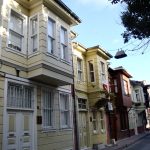“Hooped Stone”
At Çemberlitaş what was Divan Yolu, the old Roman Mesa, changes its name to Yeniceriler Caddesi (Janissary Street). Today the Çemberlitaş Meydanı that stands on the site of the original Forum of Constantine is a rather messy area hemmed in by a tram stop that sits right beside the rather ugly “Hooped Column” that gave it its name.
Ugly it may be but the Çemberlitaş is nonetheless one of the city’s oldest and most important monuments, one of the few relics to survive from the reign of Constantine the Great, the man who, in 330, made Byzantium into the capital of the Eastern Roman Empire. Originally 10.7m tall, the column was made of solid porphyry and was topped with a statue of Constantine in the guise of Apollo, the sun god, holding a red apple in his hand. Beneath it were buried an assortment of relics including pieces of the True Cross.
In 416 the column was so damaged by an earthquake that it had to be bound together with metal bands. Then in 1106 the statue was brought down by a storm and replaced with a cross by Emperor Manuel I Komnenos. This, in turn, was removed after the Muslim conquest in 1453, since when the column has been repaired on several occasions including as recently as 2009.
Around Çemberlitaş
Many visitors come here to visit Çemberlitaş Hamam (Tel: 0212-522 7974) which was probably designed by Sinan in 1584 for Nurbanu Sultan, the powerful wife of Sultan Selim II. Despite its inconspicuous entrance, virtually hidden between the shops, this is one of the city’s finest hamams and one that makes a particularly good introduction to the joys of the Turkish bath for those a little unsure what to expect.
Until recently male bathers had a much better experience than women because although this was a true çifte hamamı with separate and equally lovely sections for men and women, the women’s changing area had been lost to road-widening, leaving only a cramped space in which to undress and nowhere to relax afterwards. Happily that situation has been rectified and women are now assured of just as enjoyable a visit as their male partners.
Facing the hamam across the tramlines is the small Köprülü Cami dating back to 1659-60 which was originally built as the dershane (lecture hall) of a medrese for Köprülü Mehmed Paşa and his son, Fazıl Ahmed Paşa. It formed part of a complex with the small library down the road on Divan Yolu and with the enormous Vezir Hanı which stands just a few doors north of Çemberlitaş Hamam as you walk towards the Nuruosmaniye Cami. For the time being this is still in a decrepit condition, a situation I’m sure will be remedied any day soon. At one time it seems that merchants staying in this vast early hotel would have been able to make use of the hamam without having to step back out into the street.
On the westerly side of the Çemberlitaş stands the small Atik Ali Paşa Cami, its courtyard frequently overrun with cats. The mosque dates back to 1496 and once formed part of a complex, the only other remaining part of which is the medrese on the far side of the tramlines. Nearby, a plaque over a door commemorates the nine-week stay in 1910 0f the writer, Pierre Loti (1850-1923), who gave his name to a cafe in Eyüp at the end of the Golden Horn.
This is a part of town almost too endowed with külliyes (mosque complexes) although some only survive in part. Almost next door to the Atik Ali Paşa is the Koca Sinan Paşa complex whose medrese is home to the Balkan Turkish Association. Sinan Paşa was the grand vizier responsible for the capture of Yemen in 1569. He is buried in a 16-sided tomb facing the medrese which was designed in 1593 by the architect, Davut Ağa, a pupil of the great Sinan. The complex particularly adds to the beauty of the street because it is fronted by a stone wall pierced with metal grilles that look onto the graveyard. Finally, at the street corner, it is completed with a pretty sebil, one of the public water dispensaries that must have added so much to the comfort of life in Ottoman times.
Across the street from the sebil is the delightful Çorlulu Ali Paşa mosque and medrese complex dating back to 1708 when it was built for one of Sultan Ahmed III’s grand viziers. Today its courtyard fills up with a mixture of tourists, locals and students from the nearby İstanbul University drinking çay and puffing on nargiles. Their enjoyment might be mildly diminished were they to ponder the fact that Ali Paşa was beheaded in 1711 and his head returned from Lesbos to be buried here.
Finally, just across the street is the battered Kara Mustafa Paşa complex built in the second half of the 17th century for a grand vizier who had taken part in the failed assault on Vienna for which he, like Ali Paşa, paid with his head. The complex consists of another sebil to go along with an octagonal mosque and a medrese that claims to be a museum in memory of the poet, Yahya Kemal Beyaltı (1884-1958).
Off Yeniceriler Cami
Tucked away in the back streets behind the Kara Mustafa Paşa Cami is the Gedikpaşa Hamam (Tel: 0212-517 8956), built in 1474 for one of Sultan Mehmed II’s grand viziers and still in use today after extensive restoration. Like Çemberlitaş, it is a çifte hamamı with separate sections for men and women.
Transport info
Most people will find Çemberlitaş an easy walk from Sultanahmet although there is a tramstop here as well.
Nearby areas


